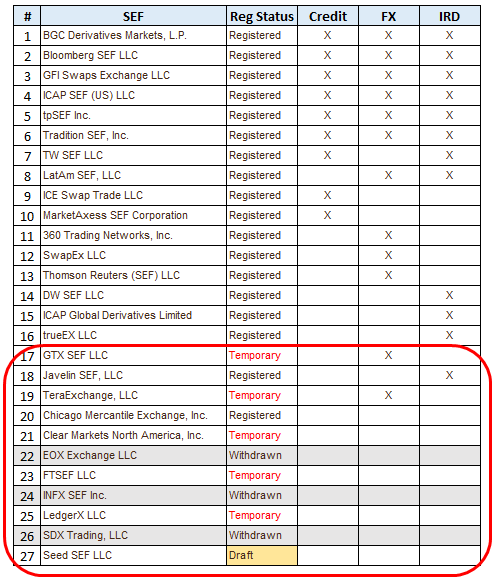Big news in SEF-land last week was the formal registration of 18 of the 20+ SEF’s. Generally speaking, chances are that if you have traded on a SEF, it has become fully registered.
The news prodded me to go have a look at the list of SEFs on the CFTC website. In doing so, I was reminded of the time a couple years back when I first began blogging about SEF registrations. At the time, it was interesting to track what seemed to be a mad rush to get into the business of transacting OTC derivatives. When SEF trading formally launched in October 2013, the number of SEFs stood at roughly 20, yet nearly every “expert” claimed that some SEFs would quickly die out and we’d end up with just “a handful”.
Fast forward two years to today, and with only a few exceptions, the number of SEF’s has done the opposite – it has grown. Why would that be? Is it the allure of competing in an industry where the competition charges staggering trade fees such as $5 per ticket – or in some cases – free?
BREAKING IT DOWN
If you are a subscriber to Clarus SEFView, or even just an avid reader of our blogs, you would know the usual names. Indeed all of the usual names are now registered.
I’ve attempted to summarize the SEF registrations in the table below. I have simplified it – instead of using trade volumes, I have simply put an “X” in the box if we have seen any activity from them since inception in that asset class.

The purpose of this blog is not to discuss the usual 16, but rather to look at the rest of the pack from 17 on down:
- GTX SEF. This is Gain Capital’s FX NDF offering, apparently just another FX ECN caught out by rule 88. They were relatively late in registering (Spring 2014) and began reporting activity in the Spring of 2015. They seem to be gaining traction.
- Javelin. Javelin was one of the original two pure “startup” SEFs. It’s quite rare, but we occasionally see rates activity from them; and they continue to make small commotions from time to time. I wouldn’t think you can count them out yet.
- TeraExchange. The other pure “startup” SEF that was around at inception, however did not get full registration this time around. They seemed to have pivoted from rates and credit into bitcoin FX NDFs. They have even done a bitcoin NDF – shame it got them in trouble by the CFTC. (Editors note – they seem to have done a few more BTC NDF trades since then).
- CME. By all accounts, the CME SEF appears to be a strategic hedge, just in case they some day need to have an operative SEF. No activity seen.
- Clearmarkets. This one is up and running, but only in Japan as an ETP. No US SEF activity to report as of yet.
- EOX. Their submission was withdrawn.
- FTSEF. FlexTrade’s SEF. A recent SEF filing. Joe Rennison of the Financial Times found that they chose to copy/paste their rulebook from Thomson Reuters.
- INFX. Integral’s SEF. Withdrawn.
- LedgerX. Another Bitcoin SEF, this one for Bitcoin options. No activity yet. Interesting to note that both “Bitcoin SEF’s” are not fully registered yet.
- SDX Trading. SuperDerivatives SEF. This appears to have been withdrawn after ICE acquired the firm.
- Seed SEF LLC. There are no public documents on the CFTC website about these guys.
So to summarize:
- Out of the 27 listed SEFs, 3 have been withdrawn, leaving us 24.
- Of those 24, 2 of them (Tera and LedgerX) are bitcoin SEFs that have not done much of anything. That leaves us 22.
- Then we need to remove the generally inactive ones (Javelin, CME, Clearmarkets and FTSEF). That leaves us with 18.
- Of the 18 remaining, there are the big 16 active SEFs that we see on a daily basis.
- Let’s now add GTX which has begun doing business in 2015.
- That leaves us with just one remaining. Seed SEF LLC.
What the heck is a Seed SEF?
SEED SEF?
Interestingly, there are no documents for Seed SEF filed with the CFTC, and they appear in “draft” status. In an attempt to figure out who they are, I of course turned to google, which led me to their LEI. It turns out Seed SEF is registered to a company based out of a 4 bedroom house in Colorado.
 What is a 4-bedroom house in Colorado doing running a SEF?
What is a 4-bedroom house in Colorado doing running a SEF?
Hemp NDF anyone?
I then managed to find the Seed SEF LLC website, which touts their exchange for “alternative commodities”. Is hemp even under the authority of the CFTC?
I suppose we will have to wait and see.

Thank you for your interest in Seed SEF. Seed CX and its subsidiaries are organized under the laws of Delaware. Seed SEF has a registered office in Chicago, IL.
Seed CX is the holding company for a couple of platforms that are being launched to serve illiquid and new commodities. One of products includes hemp and hemp derivatives marketplace. The cultivation of low-THC hemp was made federally legal by the 2014 US Farm Act under supervision of the individual states’ Agricultural Departments. Since then, a number of states all developed programs to permit industrial hemp cultivation.
Seed applied to the CFTC for registration of our SEF on January 19, 2016. Seed SEF plans to launch cash-settled derivatives to facilitate hedging by producers and processors in compliance with Federal rules for entities that facilitate swap trading. Our vision for Seed SEF is that it will serve as both a price discovery venue and a risk transfer marketplace for an exciting emerging agricultural industry.
Seed CX and its subsidiaries have nothing to do with marijuana production, processing, trading, merchandizing or consumption.